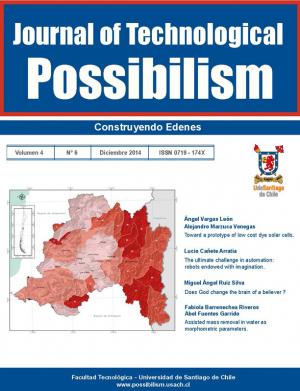Editorial - Lucio Cañete Arratia - Download
Toward a prototype of low cost dye solar cells - Angel Vargas León y Alejandro Marzuca Venegas - Download
- Abstract: The emerging technology of dye solar cells is analyzed from different points of view in comparison with silicon solar cells. The high efficiency (20%) and long durability (20 years) of silicon cells are very attractive qualities, however their high price for house electricity, make them unreachable by common people; their manufacture is energy consuming, contaminating and request high technology procedures. An lternative autonomous way is investigated, focused on testing materials and procedures for making dye solar cells at low cost, low environmental impact and reasonable efficiency and durability. Moreover, the empowerment of this technology by people was analyzed. The results are: dye solar cells 5cm2 with photo voltage production of 0,7V and photocurrent 0,2 mA, employing crystal violet as a dye. Manufacture was with low price materials, low environmental impact and learning of basic scientific background and procedures by a team of high school students. Durability requires a longer observation time and efficiency is still too low (0,05 %) in comparison with expectations of 1%, due to low production of photocurrent. Different ways to improve efficiency are proposed.
- Keywords: Dye solar cells, energy autonomy, science education, empowerment.
The ultimate challenge in automation: robots endowed with imagination - Lucio Cañete Arratia - Download
- Abstract: This essay proposes a line of investigation related to decisional processes in robots, specifically through the concept of imagination. The diversity of behaviours in these automatons can be enhanced by means of an increment of the alternatives which the robot has to evaluate and by means of an increment in the number of variables of the utility function in each alternative. In this context, with prior revision of the concept of imagination in human beings and taking keys both from Biologically Inspired Cognitive Architecture and Cybernetic, this article introduces the concept of Imagination Potential as a measure of decisional capacity that can be expanded in the robots.
- Keywords: imagination, robot, decision making, behaviour, challenge.
Does God change the brain of a believer? - Miguel Angel Ruiz Silva - Download
- Abstract: This paper summarizes evidence that shows how the brains of people who believe in God, have a different structure and function with respect to those who disbelieve. There is also evidence that believers while praying produce changes in their physiology that positively impacts their health. Since belief is somehow a matter of will, the approach to religion can be a way to improve welfare and to face more appropriately harsh environments.
- Keywords: God, Brain, Neuroscience, Neurotheology, Neuroreligion.
Assisted mass removal in water as morphometric parameters - Fabiola Barrenechea Riveros y Abel Fuentes Garrido - Download
- Abstract: Chile, for its natural geomorphological structure, constantly has recorded several natural events that have been causing a huge number of losses, both human and material, most of them concentrated in its Central Zone. The most common natural events in the Central Zone are floods and mudslides, given by the topographic and climatic features present in that area, with an a large mountainous area and rainfall periods when the soil is devoid of vegetation , thereby dragging materials that are deposited in the lower valleys. That is why this study seeks to determine areas with landslide threat as a tool to support decision-making authorities who are facing emergency situations. The methodology was adapted from the Ministry of Public Work method in the “Study of Environmental Facets”, consisting in the intersection of hydrographic parameters using a Geographic Information System, through the use of tools such as the Model Builder. According to the results, the Metropolitan Region of Santiago has a large percentage of its surface with the threat of mass movement processes, indicating that the instruments of land should consider this type of study when planning to use the territory.
- Keywords: hazard, hydrologic morphometry, landslide.

